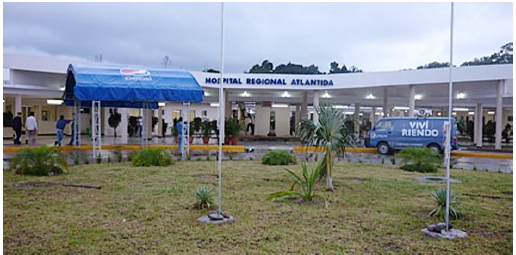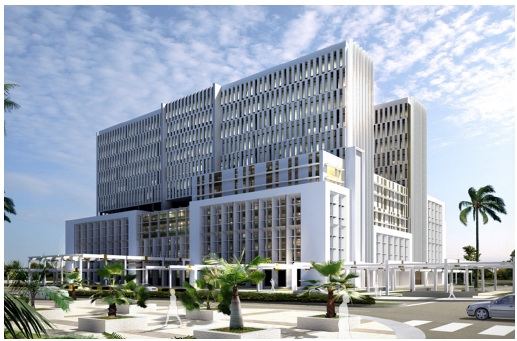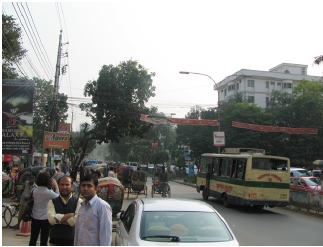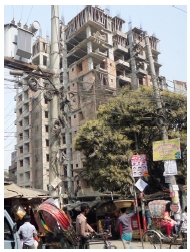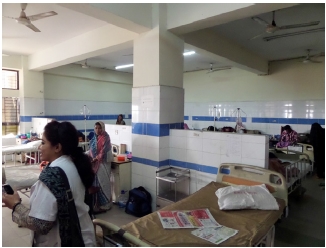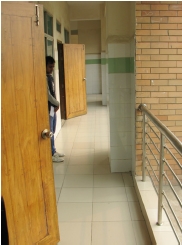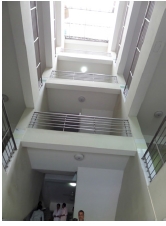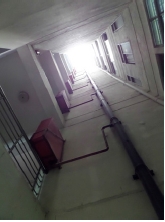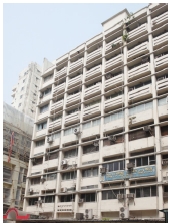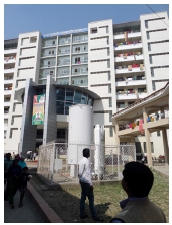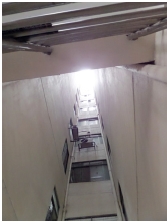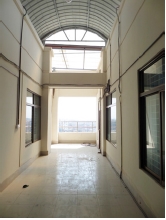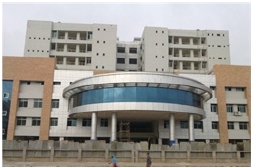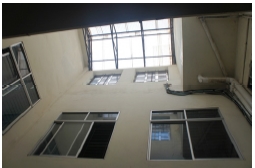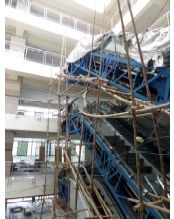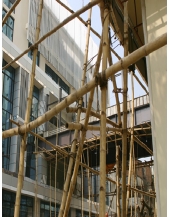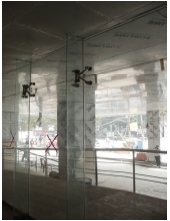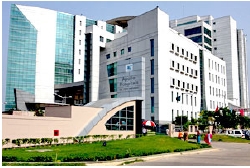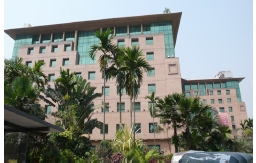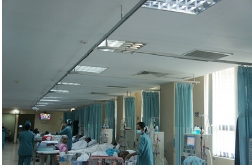
Improvement of Environmental-friendly Hospital Design on Underdeveloped Countries
ⓒCopyright Korea Institute of Ecological Architecture and Environment
Hospital design technology of Korea has recently been exported to underdeveloped countries through the EDCF business. This business reflects our high technology of the hospital design and the regional features that reflect the natural environments, the architectural features and the architectural technology of underdeveloped countries. In accordance with the trend of the global environmental-friendly design market, introduction of environmental-friendly design is needed in the project of hospital for underdeveloped countries.
A result of examining the Bangladesh case, the hospital design for the underdeveloped countries already contains a lots of environmental-friendly design elements which have lots of effect. In addition, these environmental elements already contains the advantage and efficiency of operation. Thus, for the success of the hospital design project of the international assistance business, it is necessary actively to discover the environmental-friendly design elements of the region, and to survey the environmental-friendly construction of the region and to make the guidelines of environmental-friendly hospital design during the feasibility study phase.
Keywords:
Underdeveloped Country, Environmental-friendly Hospital Design, Bangladesh1. Introduction
1.1.Research Background and Objective
Domestic hospital design technology has recently been launched to underdeveloped countries through official development assistance business project. The current trend of their development is shifting social key businesses to welfare businesses that enrich quality of life such as hospitals. Accordingly, more hospitals are designed and constructed in underdeveloped countries. One of the key features of official development assistance business project is that even though a project orderer is a beneficiary but all the construction processes are managed and heavily depend on domestic technology financed by public fund. Therefore, important is how domestic technology is applied to the local market. In this paper, this business project is simply called “Assisting Hospital Project”.
The domestic technology exported through this assisting hospital project applies its superiority to the local market and also reflects in its technology the environmental and architectural characteristics of underdeveloped country and its construction market in full. Hospital design for underdeveloped countries should conform to the culture and policies of the country. The introduction of domestic hospital design technology is important in that it can suggest the direction to the improvement of the hospital environment and development of the country. Therefore, this project should be dealt with discretion. It is also necessary to make the best of the strength and strongpoints of local hospital construction that has been cultivated and employ our technology properly to the beneficiary's market to develop its hospitals and environment gradually and step by step.
While overseas launching of hospital design is getting more apparent, setting a proper direction is important to succeed in hospital design business in underdeveloped countries. In this respect, the present study intends to discuss the direction to improvement of hospital design business, mainly focusing on assisting hospital project that has recently been made and a case study of Bangladesh.
1.2.Method and Scope
Overseas entry of hospital design can be separately discussed for developing and underdeveloped counties. In developing countries, newly built hospitals are constructed in accordance with the models of advanced countries and JCI. However, those in underdeveloped countries is still far from JCI standards and thus inferior in medical service quality and expenses. Therefore, this study limits discussion to the entry of hospital design in underdeveloped countries.
The recent hospital projects in Tanzania, Uzbekistan and Bangladesh, which are assisting hospital business projects, will be examined in this paper. Especially, some major hospitals in Bangladesh, which are currently under construction with scale of 1,000 beds (first in the country), will be focused. To do so, field survey was conducted 4 times. Based on it, discussion will be made on the current status, problems and improvements of the construction. In addition, a direction to supplement feasibility test that has been a major guideline for assisting hospital construction will be presented.
2.The Current Status of Domestic Hospital Design for Underdeveloped Countries
2.1.Hospital design through Assisted business project
Official development assistance business project earnestly began in Korea when ROK joined DAC (Development Assistant Committee) under OECD in 2008. This business project commences with loan assistance from EDCF fund of Korea Export-Import Bank and free aid from KOICA. The scale of overseas assistance was 980 billion KRW in 2010, 1 trillion, 425.5 billion KRW in 2013 and scheduled to be 2 trillion and 980 billion KRW (approved amount only) in 20141). A total of 9 trillion and 391 billion KRW of EDCF, which Korean governments founded in 1987 and have managed until now, were granted to 299 business projects in 50 countries as of 20132). In addition, the current government is in discussion of inviting the capital from private sectors as well as EDCF from 2015 and thus overseas projects are expected to grow3).
Domestic entry of hospital design to foreign countries is conducted in various ways including wining overseas construction along with domestic construction companies, or/and assisting hospital design projects. Of them, entry of hospital design into underdeveloped countries is mainly by assisted business project and domestic design technology and construction technology have great impact on the project. Since assisted business projects in the past largely focused on infrastructure construction, hospital design projects are relatively new and mostly has taken place recently.
For example, there are Honduras Atlntida Hospital (completed in 2011) and Muhimbili University Hospital in Tanzania (scheduled to complete in 2014). And Children's Hospital in Uzbekistan and BSM General Hospital in Bangladesh are construction now.
Honduras Atlntida Hospital is the largest general hospital in the country, with 250 beds. It was a project to improve the quality of local medical service in Atlntida to the north of Honduras.
Muhimbili University Hospital in Tanzania completed its feasibility study in 2009 and has been constructed by a domestic construction company since 2013. His project is being constructed in Dar-es-Salaarm, the largest city in Tanzania, with scale of 9-store above and one store below the level. This project is for both the general hospital main building and its annexes. It has 600 beds4).
Children's Hospital in Uzbekistan completed its feasibility study in 2013 and is ready to select design. The hospital is supposed to be as big as 275 beds, including 20 beds for ICU and 5 beds or NICU. Total construction cost is 100 million dollars. It will be built in Tashkent, capital city of Uzbekistan as children's hospital with high-tech equipment to improve children health, which is poor.
BSM General Hospital in Bangladesh completed its feasibility study in 2014 and plans to select design. With a total of 1,000 beds, this general hospital project is a separate annex building to the existing BSM Medical University hospital. Total project cost is expected to be as large as 120 million dollars. Considering the characteristics of the region, this hospital will deal with a variety of medical areas including heart diseases, diabetes, liver diseases and bone marrow and kidney transplant, which are not infectious diseases. Especially, this hospital project is the first in kind by credit assistance of Korea Export-Import Bank and free assistance of KOICA.
International Council for Cooperation and Development under Prime Minister's Office defines 'official development assistance business project' as a government or public institution lend donation or concessional loan to a beneficiary with objective of improving economy and welfare. The qualified beneficiary is renewed every 3 years and EDCF (a sort of concessional loan) tends to keep growing in size.
Since EDCF is financing, it is possible to finance as long as a beneficiary is eligible for the loan. Therefore, it more finances medical facility business that has been scaled up. In addition, business construction project by EDCF concessional loan has merits in that it makes it possible to control the project inside and encourages a beneficiary (country) to have a sense of ownership and responsibility. Furthermore, it can prevent the finances of economic development investment from drying out. With these business strengths, such projects are expected to grow further.
The needs of improving life quality and completing major infrastructure by underdeveloped countries will pave smooth way for Korean advanced medical industry to enter the markets.
Assisted hospital business project is developed upon the request of a beneficiary country. It carries out feasibility study and reviews business stability. And then the project completes after business review, monitoring and post-management. The result of feasibility study is critical for business direction and guideline. Especially, it is more important for building design sector. Therefore, a guideline that includes appropriate environment-friendly design direction and plan should be included in feasibility study.
2.2.Analysis of Prior Assisted Hospital Business Project
The analyses of business feasibility study for precedent assisted business construction projects are summarized as follows. When reports and drawings are comprehensively reviewed, it is found that the survey of environment-friendly items was not well considered during field survey. Accordingly, most of case, environment-friendly design guideline was not included in the report of feasibility study5).
However, it is positive to see that there has been consideration of environment-friendly aspects in a project by architects.
Judging from the fact that engineering guideline and construction program were described very in detail, it is not impossible to apply environment-friendly guideline. Particularly, one case, though not separated as individual item, it includes the contents of environment-friendly design. It is a very positive change.
3.The Current Status of Hospital Construction in Bangladeshi6).
3.1.General Information of Bangladeshi
Bangladeshi is a country located in Southern Asia and adjacent to India, Myanmar and the Bay of Bengal. The nation uses Bangla like people in West Bengal in India. Since it is under subtropical monsoon climate, winter is warm. During summer, from March to June, it is hot and humid and struck by monsoon from June to October. Annual average temperature is 26oC and monthly average precipitation is 204mm, average humidity is 73-100o. Drought, flood and cyclone are often observed in Bangladeshi.
Dhaka - the capital city of Bangladeshi is divided into old and new districts by the river flowing through the downtown. Traffic infrastructure in the city is not sufficient. During daytime, particularly, traffic is always jammed due to low rate of roads. Moreover, when hartal, which is mass assembly, often takes place due to political unrest, the roads do not function at all.
Since electricity supply is not sufficient, major buildings have to have self-power generator. Although water and sewage infrastructure has developed to satisfactory level in terms of quantity, they are still poor qualitatively.
3.2.Current Status of Construction Market
In Dhaka city, demand for rental estate keeps growing due to overpopulation and many sites are under construction. However, construction technology has been much advanced, so that the city needs modern construction machines and equipment desperately. Because the region is in want of aggregate to great extent, so they break up bricks to make aggregate to use. Therefore, construction material market and trucks are concentrated by the river where brick factories are located.
The architectural language that Louis Kahn used on the National Assembly of Bangladeshi is reflected in many buildings of the city. It is an aesthetical characteristic of the local architecture.
Curtain wall is in fad in construction sector and most of the buildings are built of bricks in pure framed (Rhamen) structure. Bangladeshi is able to make exposed mass concrete and often use wet finishing for building. Exterior of a building is often finished with painting. Expensive materials like aluminum and panels are used for major private buildings. Most of key finishing materials are imported.
The approval of private hospital building is granted by RAJUK and public building construction is managed and approved by PWD (Public Work Department) and DOA (Department of Architecture).
3.3.Current Status of Medical Market and Characteristics of Bangladesh Hospital Construction
The medical environment in Bangladesh severely suffers from the lack of beds. According to MOHFW (health administration), there were a total of 123 medical institutes (including the 2nd and 3rd hospitals) in Bangladesh as of 2012. Of them, 39 3rd hospitals, which consist of university hospitals and specialized hospitals, have only 15,390 beds. That is, 0.6 beds in 1,000 populations, which is 18% of the average (3.4 beds) of OECD.
In Dhaka city, a total of 46 2nd and 3rd public hospitals including existing BSM Medical University hospital, 7 special hospitals and 8 university hospitals, are in operation. They take 38% of total 2nd and 3rd hospitals in the country. Although Dhaka city has the highest number of beds per 1,000 populations among 7 divisions of Bangladesh, it is still far below the world average (7/3/1,000).
The general characteristics of Bangladesh hospital construction, except Blocked Hospital and Apollo Hospital, which are recently built private large hospitals, have similar traits. These two large hospitals were designed and constructed by foreign architects in accordance with hospitals in advanced countries in terms of facility and standards. Other hospitals were built by local construction technology. In this paper, public hospitals, which take the most pie of Bangladesh hospitals, are the focus of investigation7).
① Allocation and Composition of Hospital
The hospitals in Dhaka city with more than 300 beds, most of which are general hospitals and special hospitals like BSM Medical University Hospital in affiliation, are trying to secure more beds through extension construction of blocks. Many of the existing hospitals are horizontal low store buildings but newly built hospitals are being built with vertically 10-story buildings to increase the efficiency of land use. And underground work is mainly limited to the first basement level due to the consideration of the level of local construction technology and land quality.
Allocation for the external space of a hospital is mainly focused on its functional aspects such as access and connection road so no separate outdoor space or sharing yard are not secured for patients.
② Ward Block
It consists of central common hall or open indoor hall and light well on floor for natural lighting and ventilation and patient's rooms are allocated on the both sides of it. The rooms have external passage way facing the air for natural ventilation and public toilet. Natural ventilation and lighting are basic and primary in designing a hospital in this country. One ward block is often composed with one nursing block in nightingale type for natural ventilation and lighting.
Patient ward consists of chargeable and free-of-charge patient's rooms, which is administrative classification, but they are all same in terms of architecture. The ward is finished with tiles and paints and equipped with minimum artificial lights, ceiling fans and supply pipes of medical gas. It is not equipped with air-conditioning facility and toilets are located outside of the patient's room for common use.
Apollo Hospital and Blocked Hospital, which are newly- built private large hospitals, installs air conditioning and refrigerating equipment in patient's room.
Some of the patient's rooms in public hospital have rooms called 'CABIN', which is a single or only two-person room, to provide premium service and improve profit structure, attended on by separate nursing block. The number of CABIN is decided within 30% of the total beds according to local law.
③ Emergency Block
Located on the level ground, emergency block building has a separate access road. The beds are allocated in nightingale type. Sickbeds are grouped and divided by tiled concrete wall of 1.2 meter high. Tiles are used for finishing of both floor and wall.
④ Kitchen and Dining Hall
Hall-typed kitchen, where cooking is made on a low cooking counter more or less 30 centimeter high from the floor, is placed in a hospital building. This kitchen is mainly for inpatients and it is in principle that every meal is provided. In a hospital that was built long ago, there is a common cooking space, located between public stairs, for patients to cook by themselves. But recently built hospitals do not have such space. Dining hall in a hospital is only open to workers of the hospital but recent large private hospitals (Blocked Hospital and Apolo Hospital) run cafe-typed restaurant for visitors separately.
⑤ Facility and Others
This region faces blackout frequently, so self-power generation system is installed in a hospital. Power substation takes separate space outside and supplies power from there.
Separate garbage collection system is not implemented and medical wastes are collected and disposed by a service company. Waste water treatment tank and septic tank are prepared at separate space underground next to the hospital building.
Air-conditioning system does not work on the whole building. Natural ventilation space and light well are utilized in full for the purpose.
4.New Trend of Newly Built Hospitals
4.1.Newly Built Public Hospitals
The expanded block of the affiliated hospital to Dhaka University, NINS hospital (National Institute of Neurosurgery Hospital) and the newly built outpatient hospital building of BSM Medical University are the only large general hospitals that were built in Dhaka city between 2013 and 2014. In addition to them, a feasibility study is currently underway for a new 1,000-bed general hospital of BSM Medical University, which is Korea-supporting hospital construction project.
The new hospital building was constructed with by the local design technology. Constructed and completed in 2013 behind the existing Dhaka University Hospital, the new hospital building is comprised of one basement level and 10 stories with a total of 500 beds. It consists of outpatient block on lower stories and ward block on the upper stories. This building has symmetric shape. To the left, nursing block is located in nightingale type.
The perimeter of the ward block located on the upper stories has toilets, corridors or balconies at the outside. It was designed focusing on natural lighting and ventilation.
The core space of the building mass has stairs at both ends, so that natural light comes inside. And supplementarily, the light well of the center and the lighting corridor of the perimeter are invited inside for ventilation and lighting.
NINS is one of the national special hospitals in Dhaka city. It was built with local design technology in 2013. The hospital has a total of 300 beds and wards are located to the right and left from the large and wide indoor hall. Ward block consists of chargeable and free-of-charge patient's rooms. There is no physical different between the kinds. Each patient's room was designed for 8 patients per room. The rooms has hallway outside to which they are open. Patients and their guardians use this space to the common bathroom connected to the hallway.
In the middle of the building, there are indoor hall and light well for natural ventilation and lighting.
The building does not have heating/air-conditioning system inside it but keeps a pleasant environment by using natural lighting and ventilation. Each room has a ceiling fan on the open ceiling to make air stream.
Operation rooms and intensive care units have separate heating/air-conditioning system and also the research lab that needs system has a separate system built in the wall.
Being scheduled to complete in late 2014, the outpatient unit of BSM Medical University is currently underway for expansion. The main hospital building was designed by local construction design and technology. Esthetical focus is given to the outpatient block due to its characteristic. The walls of the building are made with concrete Rahmen framework and bricks but finished with aluminum grids and panels to give esthetic value. The grills to the exterior play a partial role of screening light.
The newly built outpatient unit was designed with natural ventilation and lighting in attention. Light well is located at the core of the building mass that connects in all directions. What make this building noticeable is that it is equipped with escalators, which is the first in the region, to enhance service quality and patient status though it is a hospital, unlike the existing outpatient unit. In addition, the building was designed to apply SPC to the front window at the entrance of the lobby on the first floor, which is the first in kind for hospitals.
The latest trends of newly built public hospitals can be summarized as follows.
Public hospitals do not use heating/air-conditioning system except for the facility that has direct impact on patient's life such as intensive care unit and operation room. Most of facilities for patients and guardians are designed to mainly use natural ventilation and lighting. Heating system is not installed in this country due to its climate.
External windows are openable to use natural ventilation and floors are open to indoor hall. Indoor hall makes inner air stream to help air circulate for better natural ventilation. Especially because air-conditioning system is not applied mostly, the air circulation by indoor hall plays a very important role in making optimal indoor environment. The level height of each floor is designed to be high enough to help air circulation and fans are installed on the ceilings to maintain air stream. High level is designed to accept light deeply inside.
The environment-friendly elements applied to the public hospitals that this paper adopts for case study are summarized in Table 3. The external windows of the hospitals are equipped with awning, or balconies or outdoor corridors are prepared so that they can be separated from the external surface to control direct sunlight.
Particularly, installing outdoor corridor allows common-use bathrooms, which is very negative for natural ventilation, to face the outside.
Since they are large-scaled hospital buildings, outpatient buildings are made in mass. For this, indoor hall and light well (hall) installed at the center of the mass enables lighting and ventilation to doctor's offices and research lab.
DOA (Department of Architecture) in Dhaka city, which is an authority to approve construction, is aware of the importance and direction of environment-friendly building, there is no specific instruction or guideline for it. On the other hand, more urgent is supply of electricity. The authority makes a mandatory recommendation for the installation of PV power facility. The standards regarding the scale and power amount of PV power facility are supposed to be decided by licensing institute during discussion of construction8).
In general, the main wall finishing method for existing and newly built hospitals is concrete Rahmen frame along with bricks and painting. The newly built outpatient unit uses this finishing and adheres aluminum grids and panels to it to give esthetic effect. The private office buildings recently constructed in Dhaka city more used aluminum panels for finishing. On the contrary, dry curtain wall method is rarely applied.
Interior finishing for a hospital is mostly made of tiles that have good endurance. BSM Medical University currently under construction installed escalators in indoor hall for the first time for hospital. But most of cases, vertical passage is realized with stairs and elevators.
When summarizing the preference of hospital works with whom this researcher interviewed during field survey, it is known that they prefer tower-shaped mass building, common hall as waiting space for outpatient block. They also responded that they prefer centralized core structure. Natural ventilation and lighting was preferred for a hospital and air-conditioning was thought to be effective only for facilities that must have it. They thought that proper number of patients per a patient's room ratio was 8 beds. They answered that outdoor corridor is necessary for ward unit. These preferences allow us to look into the local awareness of a hospital.
4.2.Privately Funded New Hospitals
To understand the trend of newly constructed public hospitals from relative perspective, it is advantageous to look into the cases of privately funded hospitals. Apollo Hospital and Blocked Hospital are the only private capital-based new hospitals in the last 10 years. Located in the downtown of Dhaka city, they are expensive and most trusted hospitals.
Apollo Hospital was conceived on the fund of India Apollo Group, designed by U.S. Smith Group and completed in 2005. This hospital is the only one acquiring JCI certificate in Bangladesh. It has a general hospital with 450 beds. The medical fee is very expensive to meet the best medical service, so most of the users are expatriates living in Bangladesh and rich people.
The central lobby is open to all the floors of the outpatient unit and its front is also open to the outside, playing a role of indoor hall. The overall building is equipped with heating/air-conditioning system and the patient's rooms have inner curtains to screen sunlight instead of using external shading device. The ward unit is also equipped with heating/air-conditioning system and its double-loaded corridors are lit by artificial lighting system. The vertical path is used by elevators as main means of mobility. The hospital building does not allow open space between levels inside the building, so waiting space for treatment is prepared with the elevators that are connected to the hall9).
United Hospital is a private general hospital built in 2006 by joint investment of famous companies in Bangladesh. It is one of the most specialized in cancer treatment in the region. It has a total of 450 beds. It has earned high level of credibility on medical service from patients despite its identity as local capital-based hospital. Its medical fee is also high, so most of the users are expatriates living in Bangladesh and rich people like Apollo Hospital.
The large lobby is designed to be at the main passage of the building but vertical passage s not open. Namely, the lobby is a horizontal space on the ground floor. The users of the hospital are varied including not only Bangladeshis but also foreigners. To meet this characteristic, a small cafe is installed on the lobby.
Heating/air-conditioning system is installed all over the hospital building. Therefore, there is no awning or passive environmental structure on the outside. Sunlight is controlled by the curtains inside. Ward block is positioned on the double-loaded corridor and lit by artificial lighting10).
The following table shows the materials used for finishing work of two cases we have examined. The finishing materials were chosen by private hospital more focusing on the convenience of use and qualitative value than manageability and endurance that the public hospital paid attention to. Particularly, Apollo Hospital was constructed in accordance with JCI standards and applied with a similar design and finishing work to other chains in the world.
Since the two hospitals were designed and constructed to meet the global level of medical service and satisfaction, the whole space was equipped with heating/air-conditioning system. Foreign visitors have different sense of experience from the natives; it seems that the decision of installing heating/air-conditioning system over the buildings was very necessary.
The ward blocks are with double-loaded corridor and depend on artificial ventilation and lighting system.
The following table shows the elements of passive environment-friendly design adopted by the two hospitals. It turned out that the private hospitals apply few of the environment-friendly design elements because they have different operations and purpose from the public hospitals.
4.3.Implications from New Hospital Design
The implications of the new hospital design can be put together as follows.
The mass of a hospital building tends to be vertical and centralized to make efficient use of land. Indoor hall and light well are introduced to maintain natural lighting and ventilation.
Awning, balcony and outdoor corridor are used for the building facade to control daylight. Especially, the outdoor corridor of ward unit plays an important role as circulation system to be shared with functional spaces such as toilet.
The composition of patient's room by nursing unit used to be built in nightingale style that is effective for natural ventilation and lighting, but it has developed into a separated (divided) form for general treatment, except for sickbed rooms requiring intensive care such as intensive.
Since patients and guardians don't do outdoor activities much, the hospitals didn't consider outdoor healing space. In the meantime, common space like access pathway tends to get bigger as the number of patients increases and more people use it.
As the enhancement of medical service is reflected on the development of architecture space, common space such as lobby and waiting room and healing space is improving in terms of function and air-conditioning of such space is expected to be greater in a long term.
Although there is no architectural difference between chargeable and free-of-charge patient's rooms, CABIN-typed patient's rooms are increasing in number to improve business profits and provide medical service of better quality to patients.
The case of the newly expanded outpatient building of BSM Medical University Hospital showed that hospital space is changing to accommodate largesized medical equipment and devices as they develop and to be specialized treatment space for new medical service.
It was demonstrated that natural ventilation and lighting are preferred for environment. Especially, interviewees expressed that natural ventilation and lighting are very necessary in the outdoor corridors of the ward block.
Despite the continuous development of Bangladeshi hospital architecture, ventilation와 natural lighting should be duly considered for the geographical characteristics of Bangladesh.
5.Directions to the Improvement of Hospitals in Underdeveloped Countries
5.1.Introduction of Environment-Friendly Elements
Environment-friendly design is an important direction to follow for the survival of mankind regardless of the difference of wealth and culture of nations. This truth is also applied to underdeveloped countries, which mainly concentrate on economic development, for the sustainable growth to future. Therefore, they are also taking steps towards, but specific guidelines haven't yet been established. In this respect, it is very beneficial for assisted business project to propose a direction to environment-friendly design of construction.
Environment-friendly design elements applied to underdeveloped countries should be different from those normally implemented in Korea and they should embrace the elements fit to local environment. To find out such elements, it is important to find the applicable factors used in the local construction market. For this reason, research on the structures reflecting the local geographic and climatic elements and review of the current status of environment-friendly design and technology as well as existing ordinary research methods.
Based on the case studies of this paper, the environment-friendly design factors that can be applied to Bangladesh can be summarized as follows.
• Indoor hall and light well for natural ventilation and natural lighting
• Connecting passage in the building perimeter and outdoor common toilet
• Tall floor level and convention-typed air-conditioning
• Outdoor awning and balcony to control daylight
• Open access hall to improve the environment of access area
5.2.Improvement of Feasibility Study Phase
As the initial phase of assisted hospital construction design, current condition survey should be specific so that it can reduce risk factors to be found in the following phases. In general, the current condition survey for assisted business project includes all the researches and analyses when feasibility study is scheduled. Feasibility study should be conducted and reported to help come up with suitable facilities and scale, necessary medical equipment, promotion plan, guideline, business cost and architectural program, through the research of medical and construction environment.
At the architectural design phrase, which is a full-fledged phrase of designing work, design should be executed on the basis of the data and guideline of the feasibility study after simple verification. In case that the guideline and design are discrepant, it can cause problems to project budge and schedule. Therefore, the data and guideline of the feasibility are critical for successful project. For this reason, all the important guidelines and contents should be fully covered in feasibility study.
Therefore, it is desirable to add the phase of proposing a direction to environment-friendly design to secure environment- friendliness to the assisted hospital design business project for underdeveloped countries, before the phase of preparing guideline.
5.3.Improvement of Design Phase
As examined in the case studies of precedent assisted hospital design business project, business cost and construction cost have a great impact on the main architectural design phase and accordingly it is hard to add other environment-friendly elements than specified in the guideline in this stage. As witnessed in the case of Muhimbili University Hospital in Tanzania, some of environment-friendly elements adopted at the stage of design planning were excluded due to the burden of business cost.
Therefore, the items and phase to evaluate applied environment- friendly elements and construction cost should be included at the initial stage of planning design, which is prepared by a designated subcontractor, as well as proposing a proper guideline for environment-friendly design, for the sake of the environment- friendly design of assisted hospital design business project.
6.Conclusion
Hospital design project, which is part of assistance projects for underdeveloped countries, is an important business because Korea's advanced hospital design technology is applied to and realized in a local market.
However, if our design technology is applied to the local market without any consideration of adjustment, too much focusing on the convenience of advanced technology and technical rationality, we may bury the excellent functions and environment-friendly elements that the local architecture possesses. Therefore, the environment-friendly elements, strengths and merits of the local architecture should be thoroughly examined and reflected in our design. That is the way we really help a project beneficiary with efficient operation of hospitals hospital and financial benefits as well as the actual users with a proper level of service and convenience.
Therefore, it is necessary to steer the objective of the project (assisted hospital design business project for underdeveloped countries) toward the preservation of effective environment- friendly elements and improvement of medical service of the local market. In addition, it is also needed to improve healing environment through proper distribution of construction budge. To realize these objectives, above all, proper researches and conclusions should be made and available at the stage of feasibility study to bring forth an environment-friendly guideline to be adopted for the project. To make it sure, groundwork on which these qualitative researches can be carried out and environment- friendly guideline can be applied should be included in the guideline for the subcontractor of feasibility study. Last, effort should be made to apply environment-friendly design.
Notes
2) Korea Export-Import Bank: released on December 19th, 2013
3) Construction Economy: released on October 20th, 2014
4) Korea Construction News: released on August 12th, 2013
5) Korea Export-Import Bank reviewed 'Reports of Feasibility Study Service for Hospital Project' in Tanzania, Uzbekistan and Bangladesh.
6) The pictures were taken during field survey.
7) Filed survey was made 4 times: December, April and August 2013
8) Interview with DOA in Dhaka city: April 23rd, 2014
9) Field survey: December 23rd, 2013
10) Field survey: February 11th, 2014
References
- Lee, Ho-Sung, (2009), A Comparative Study of A Domestic and Foreign Green Architecture Evaluation Items for a Green Performance Enhancement of Hospital Architecture, Journal of Korean Institute of Interior Design, 12, p99-107.
- Seo, Young-Joon, Kang, Shin-Hee, Kim, Yeon-Hee, & Lee, Yong-Gyun, (2010), Present and Future of Green Hospital in Korea, Journal of Korea Institute of Healthcare Architecture, 38, p43-53.
- The Export-Import Bank of Korea, (2013), 2014 World Country Handbook, Korea.
- The Export-Import Bank of Korea, (2012), The Strategy of Exort of Renewable Energy Industry, Korea.
- Yoo, Kwang-Heum, Kim, Eun-Hee, & Jin, Hyun-young, (2013), An Institutional Study for the Advance of Architectural Service Industry into Foreign Markets, Korea, Architecture & Urban Research Institute, Korea.
- www.koreaexim.go.kr.
- www.edcfkorea.go.kr.
